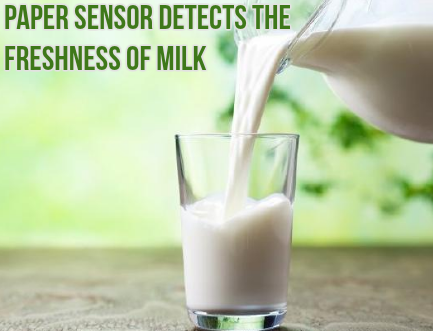With the development in technology there has been lot of changes in our lives and now the scientists at Indian institute of Guwahati has developed a paper sensor which can detect the freshness of the milk with a simple paper kit. We can known how well the milk has been pasteurized as the milk is most consumed liquid by children and seniors.
Though they are using the preservatives and freezing the milk the quality of the milk is concerned. The testing in the diary factories takes a lot of time and need complicated equipment’s like spectrophotometers. And the process is so long, this simple paper sensor can do the job easily and quickly. We also get a mobile application where we can check and consume the milk before it turns too acidic.
Detect The Freshness Of Milk By Paper Sensor
These days the sensors are used every where to make the life simple and easy. The paper sensor is a reflective sensor suitable for relatively short distance detection. Using this sensor a new invention is made in which a small kit is used to known the freshness of the milk. Alkaline phosphate (ALP) which is milk enzyme is used as the indicator of the milk quality. This is so because its presence after pasteurization indicates the presence of microbes that have been kept inactive in pasteurization.

An ordinary filter paper used in this detector which cut in to small holes using the hole puncher. These impregnated with chemical probes that reacts favorably with the ALP. The probes are antibodies that specifically stick strongly to ALP. When Alkaline phosphate comes in contact with probe, it turns the whitepaper in to a colored one. These colors scanned by the mobile phones and compared with the standard readings.
This gives the exact amount of the ALP. The 94 percentage of ALP can be detected. It takes 15 minutes to detect from raw milk to the pasteurized one. Also, you can check how to reduce stress naturally here and know more details about it.
How To Check Freshness Of Milk By Paper sensor
The test is conducted on the milk samples taken from the villages and also spiked milk. It is also confirmed that the change in color is due to the presence of ALP not due to the presence of other vitamins or proteins.
The paper sensor kit is very small in structured and made up of a 2 cm square transparent cellulose acetate film covered with another one. There are tiny holes through which we can inject the milk and the color changes can be detected using the mobile phones. The cost of the sensor is 80 to 125 rupees which is very affordable and it is very handy and can be used in large kitchens, milk diaries and places where milk freshness is concerned.
The sensor works in both qualitative and quantitative type and no other separate reader required for this. Kuldeep Mahato a researcher worked with Dr. Chandra in this development. Soon the research results going to be published in the journals of biosensors and bio electronics. For more health updates, bookmark our page Timesalert and check out all the information related to health and many more.
Contents





